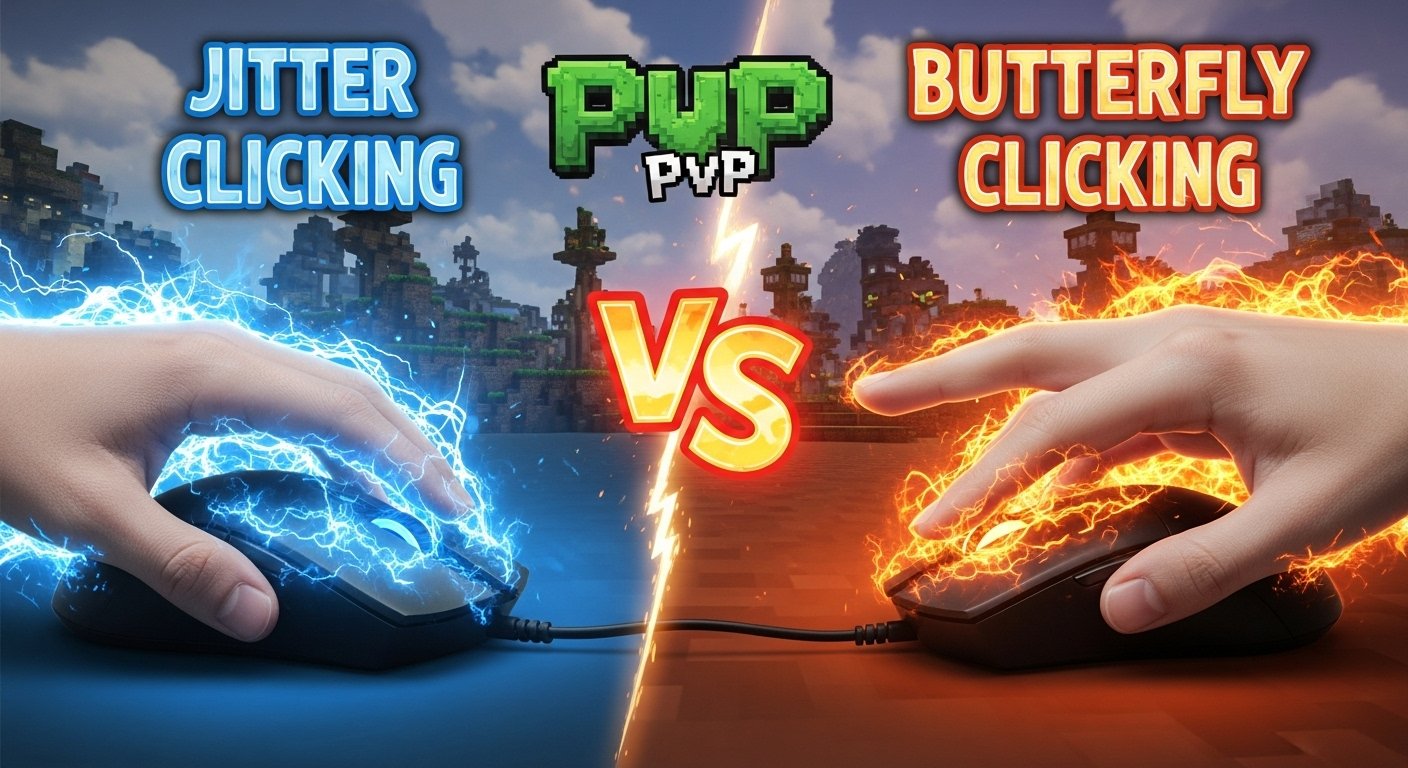You’re in a tense Bedwars duel. It’s down to the wire, and you have the advantage. You move in for the final combo, but your fingers can’t keep up. Your opponent, clicking at a speed that sounds like a hornet’s nest, overwhelms you with a flurry of hits you can’t match. As you stare at the respawn screen, the question burns in your mind: how did they do that? This is the moment every competitive player faces—the realization that normal clicking has a hard limit. It’s what sparks the great debate in the gaming community: in the battle of Jitter Clicking vs. Butterfly Clicking, which technique is the true key to unlocking god-tier speed and dominating your opponents?
Executive Summary: Your Guide to Choosing the Right Technique
This is not just another article defining clicking styles. This is a head-to-head showdown designed to give you a definitive answer. We will break down Jitter Clicking and Butterfly Clicking across five critical performance metrics, from raw Clicks Per Second (CPS) to the massive impact each has on your aiming stability. We’ll uncover the hidden health risks like finger strain and Carpal Tunnel that most guides ignore, so you can play harder and safer. Finally, we’ll deliver a clear verdict on which method is superior for specific games like Minecraft PvP and help you choose the right path to elevate your gaming skill. By the end, you’ll know exactly which technique is the right weapon for your arsenal.
What Are We Comparing? A Quick Primer on the Techniques
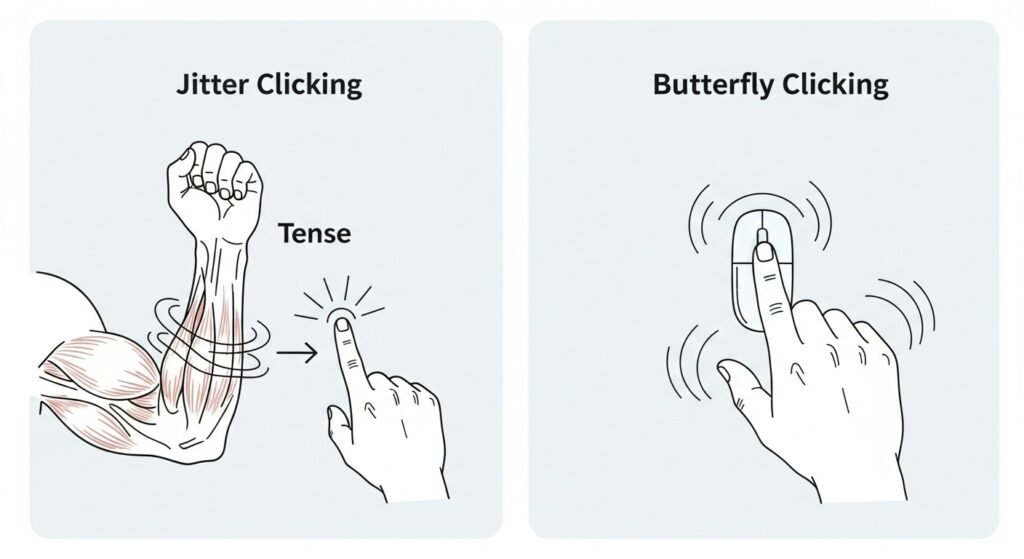
Before we can crown a champion, we need to understand the fighters. Jitter Clicking and Butterfly Clicking are two completely different philosophies for achieving the same goal: superhuman click speed. They involve different muscles, different motions, and have vastly different effects on your gameplay.
What is Jitter Clicking? (The Art of Controlled Vibration)
Jitter clicking is a high-intensity technique where you tense your arm and wrist muscles to create a rapid hand vibration. This controlled muscle spasm is then channeled through your finger into the mouse button, causing it to click at an incredible rate. You aren’t actually “clicking” in the traditional sense; you’re essentially turning your entire arm into a motor.
This method can typically produce a Clicks Per Second (CPS) rate between 10 and 16. It’s a physically demanding skill that relies on muscle control and endurance. For players looking to get started, a full guide to mastering jitter clicking can break down the complex mechanics into easy-to-learn steps.
What is Butterfly Clicking? (The Two-Finger Drumroll)
Butterfly clicking is a rhythmic method that involves using two fingers—usually your index and middle finger—to tap the same mouse button in rapid succession. Think of it like drumming your fingers on a tabletop, but on a much smaller target. The motion is light, fast, and relies on dexterity rather than brute force.
Because you are using two fingers, this technique has a much higher potential for raw CPS, often reaching 20-25 or even higher. This two-finger clicking style is also notorious for causing double-clicking on mice that aren’t built for it, a crucial point we’ll cover later. Learning the proper rhythm is key, and a dedicated guide to butterfly clicking can help you build the correct finger placement and timing.
Why Not Just Click Normally? Understanding the CPS Ceiling
For most computer tasks, regular clicking—using one finger to press the button for each intended action—is perfectly fine. It’s accurate and controlled. But in competitive gaming, it’s like bringing a knife to a gunfight. The average person’s regular click speed tops out around 6-8 CPS.
This “CPS ceiling” is a hard physical limit. In games like Minecraft PvP, where every action counts, having a higher CPS means you can place blocks faster and register hits more consistently. Jitter and butterfly clicking are the two primary ways serious players shatter that ceiling to gain a critical competitive edge. Understanding what CPS is and why it matters is the first step to becoming a better player.
The Ultimate Showdown: Jitter vs. Butterfly Across 5 Key Metrics
This is where the debate gets settled. We’re going to compare Jitter Clicking and Butterfly Clicking across five crucial categories that every competitive player cares about. There will be a clear winner for each.
Metric 1: Raw Clicks Per Second (CPS) – Which is Faster?
When it comes to pure, unadulterated speed, this isn’t a close fight.
- Jitter Clicking: A skilled jitter clicker can consistently hit a High CPS range of 10 to 16. This speed is limited by how fast your muscles can vibrate and transfer that energy.
- Butterfly Clicking: Because it uses two fingers, butterfly clicking has a fundamentally higher ceiling. It’s common for players to reach 20-25 CPS, with some masters pushing even higher. It’s simple math: two fingers clicking in succession will almost always be faster than one finger vibrating.
Verdict: Butterfly clicking is the undisputed champion of raw click speed.
Metric 2: Aiming & Stability – The Great Trade-Off
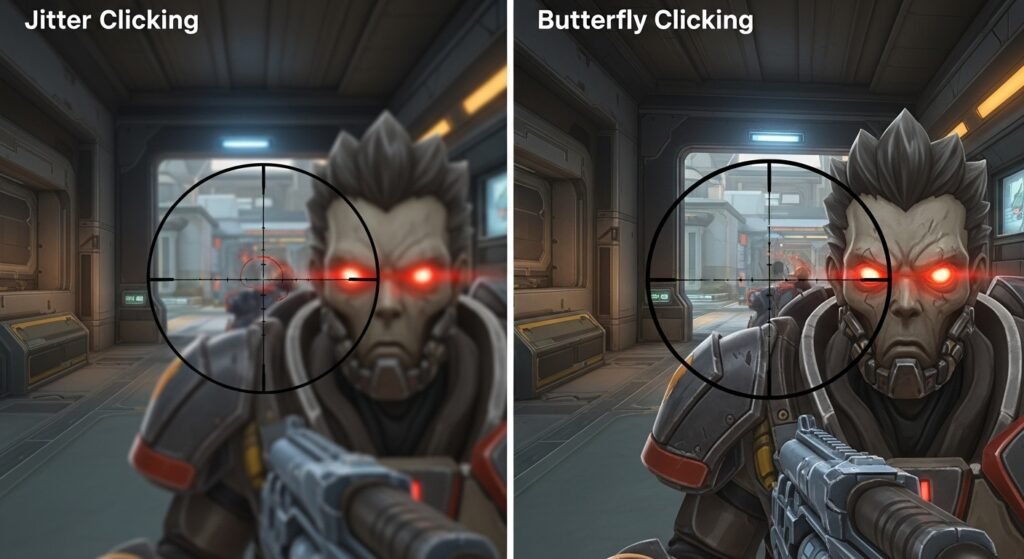
Getting a high CPS is useless if you can’t hit your target. This is the single most important difference between the two styles.
- Jitter Clicking: The intense hand vibration required for jitter clicking is disastrous for aiming. The constant muscle spasm makes precise tracking and small adjustments nearly impossible. Your aim stability plummets, making it effective only in very close-quarters Player vs Player (PvP) combat where you can “spray and pray.”
- Butterfly Clicking: This technique is far superior for aiming. The clicking motion is isolated to your fingers, allowing your wrist and arm to remain relaxed and focused on controlling the mouse. While your aim won’t be as steady as a normal click, it is vastly more controllable than the wild shaking of a jitter click.
Verdict: Butterfly clicking is vastly superior for maintaining aim and control.
Metric 3: Long-Term Health & Ergonomics – Which is Safer?
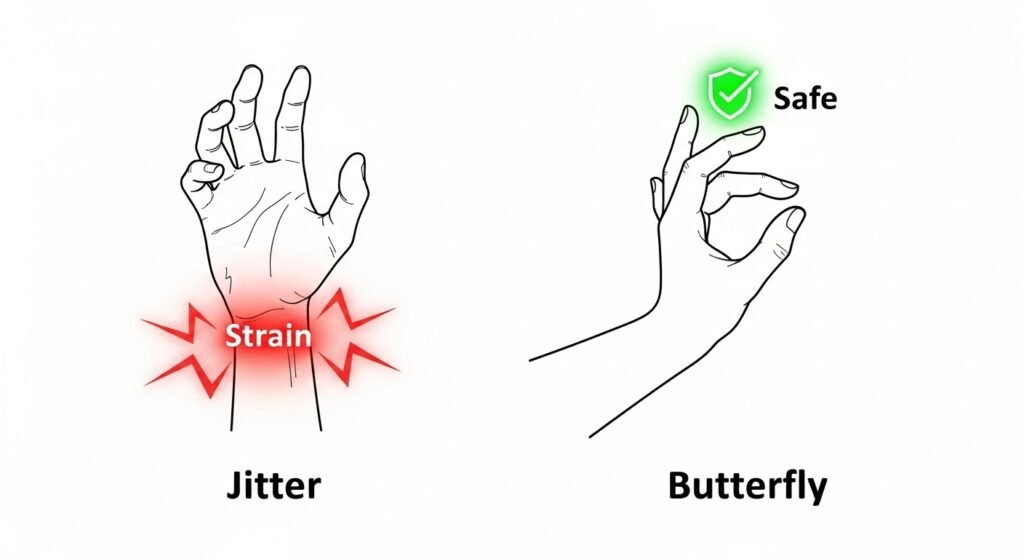
Your gaming career won’t last long if you injure yourself. The ergonomics of these techniques are critically important but often ignored.
- Jitter Clicking: This is the more dangerous method. Tensing your arm and wrist muscles for prolonged periods is an unnatural strain. It can lead to severe finger strain, repetitive strain injury (RSI), and could increase your risk of developing serious conditions like Carpal Tunnel syndrome over time. It is not a sustainable way to play for hours every day.
- Butterfly Clicking: While not entirely without risk, butterfly clicking is significantly safer. The motion is lighter and puts less strain on your tendons and muscles. As long as you maintain good posture and use a comfortable mouse, the risk of injury is much lower compared to the high-tension demands of jittering.
Verdict: Butterfly clicking is the significantly safer and more sustainable choice for your long-term health.
Metric 4: The Learning Curve – Which is Easier to Master?
Every player wants to improve quickly, so the learning curve of a new technique is a major factor.
- Jitter Clicking: The skill ceiling is high, but the entry barrier is even higher. Learning to create and control a muscle vibration is a very unnatural feeling. Many players struggle for weeks just to get the basic motion down without their aim flying all over the screen. It requires significant patience to master.
- Butterfly Clicking: This technique is far more intuitive. The motion of drumming two fingers is something most people can do naturally. Players can often achieve a decent CPS rate within their first few practice sessions. The real challenge isn’t learning the motion, but mastering the rhythm and consistency to maximize speed without sacrificing control.
Verdict: Butterfly clicking is significantly easier to learn and see initial results with.
Metric 5: Hardware Requirements – Does Your Mouse Matter?
The answer is a resounding yes, but each technique demands different things from your gaming peripherals.
- Jitter Clicking: This method is surprisingly flexible with hardware. Because you’re forcing a single, powerful vibration for each click, it doesn’t rely on fancy mouse switches or low debounce time. The most important factor is ergonomics. You need a mouse shape that allows you to maintain a firm, comfortable grip while your arm is tensed.
- Butterfly Clicking: This technique has strict hardware requirements. To register the rapid succession of two different finger clicks, your mouse must have the ability to set a very low debounce time in its software. If the debounce delay is too high, the mouse will think your second click is an accidental double-click and ignore it, completely defeating the purpose. This is why it only works on specific gaming mouse models.
Verdict: Jitter clicking is less demanding on your mouse’s internal technology, while butterfly clicking absolutely requires a modern gaming mouse with adjustable debounce settings.
Comparison Table: Jitter vs. Butterfly Head-to-Head
| Feature | Jitter Clicking | Butterfly Clicking | Winner |
| Max CPS | 10 – 16 | 20+ | Butterfly Clicking |
| Aiming Stability | Very Poor | Moderate | Butterfly Clicking |
| Health Risk | High | Low | Butterfly Clicking |
| Ease of Learning | Hard | Easy | Butterfly Clicking |
| Hardware Needs | Comfortable Shape | Low Debounce Switches | Jitter Clicking (Less Restrictive) |
The Impact on Your Gameplay: Which is Better for…
Theory is great, but results are what matter. A clicking technique is only as good as the advantage it gives you in-game. Let’s break down which method is the right tool for the right job.
Minecraft PvP (Bedwars, Duels): Where precision meets speed.
This is the primary arena for high-CPS combat. In a game like Minecraft PvP, you need to balance raw clicking speed with the ability to aim your hits and place blocks accurately.
- Jitter Clicking finds a small niche in extremely close-quarters combat where aim is less important than overwhelming an opponent who is right in your face. However, for building, bridging, or fighting at any kind of range, the lack of aim stability is a crippling disadvantage.
- Butterfly Clicking is the clear winner for almost every Minecraft scenario. It provides more than enough High CPS for rapid block placement and hit registration, while allowing you to maintain the fine motor control needed for precise aiming. You can build, bridge, and fight effectively without the wild shaking.
Case Study: How Switching from Jitter to Butterfly Improved My Bridging Consistency.
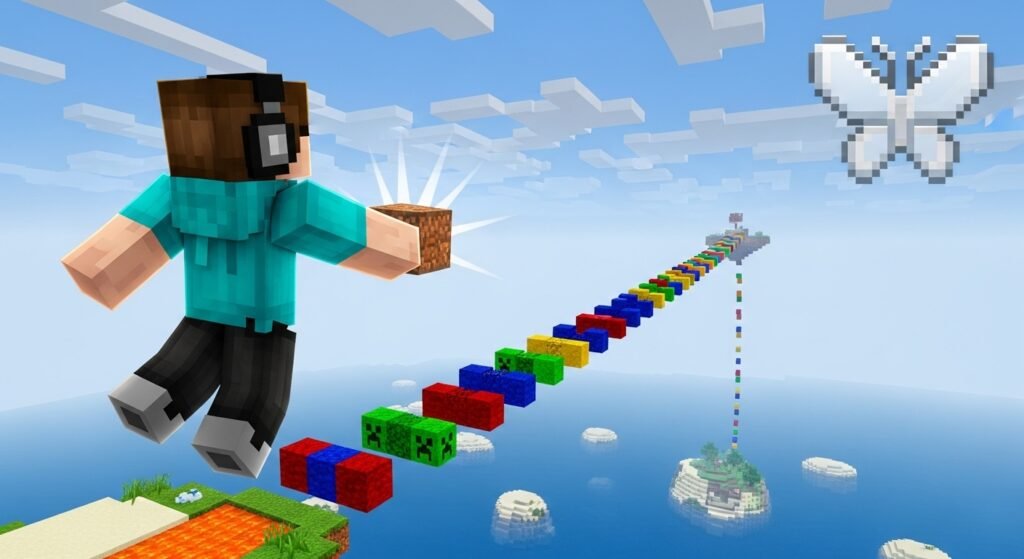
I used to be a die-hard jitter clicker. I loved the feeling of raw power and the intimidating sound it made. In close-up sword fights, I felt unstoppable. But my Bedwars stats told a different story. I was constantly falling into the void because my aim would waver while trying to speed bridge. My hand vibration made placing blocks on a narrow line a nightmare.
Frustrated, I spent a week forcing myself to learn butterfly clicking on a new mouse with adjustable debounce. The first few days were awkward, and my CPS was lower than my jitter click. But then it clicked—literally. I realized I could keep my wrist perfectly steady and just let my fingers do the work. Within two weeks, my bridging became faster and, more importantly, far more consistent. My success rate on risky plays skyrocketed. I learned a vital lesson: in competitive gaming, controllable speed is always better than raw, uncontrollable power.
Fortnite & Other Shooters: Is high CPS even useful here?
In modern shooters like Fortnite, Valorant, or Call of Duty, the conversation changes dramatically. These games have fixed fire rates for their weapons. Clicking faster than the gun can shoot does absolutely nothing.
For building in Fortnite, a high CPS can offer a slight advantage in “turbo building,” but the game’s internal cooldowns mean you get diminishing returns very quickly. A stable 8-10 CPS is more than enough.
Verdict: For most modern shooters, both jitter and butterfly clicking are largely useless. Your focus should be 100% on smooth tracking and precise single clicks, making a low, stable mouse DPI and good aim far more important than your CPS.
General Use: Can you browse the web with these techniques?
Let’s be honest: trying to navigate your desktop or a webpage while jitter clicking is a recipe for chaos. You’ll accidentally close tabs, drag files into the wrong folders, and generally cause mayhem. Butterfly clicking is a bit more manageable, but you’ll still be fighting constant double-clicking issues when you only want to click once.
Verdict: Save these clicking techniques for the game. For everything else, a normal click is your best friend.
The Hidden Danger: Double-Clicking and Debounce Time
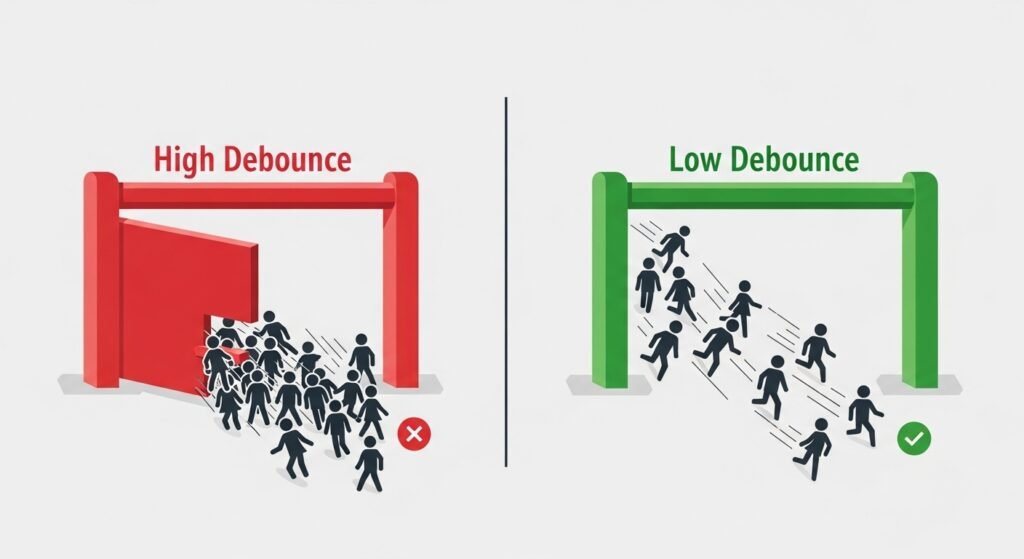
We’ve established that butterfly clicking requires a specific type of gaming mouse. The reason for this lies in a tiny, but crucial, software setting that can either unlock your potential or render the entire technique useless. This setting is called debounce time, and it’s the secret gatekeeper of high CPS.
Why Butterfly Clicking Can Betray You
Imagine a bouncer at a club door (your mouse’s sensor) who is told to prevent people from accidentally entering twice. This bouncer is your debounce time. It’s a tiny delay, measured in milliseconds, added after every click to filter out accidental “noise.” For a normal user, this is great because it prevents a single sloppy press from registering as a double-click.
But for a butterfly clicker, this is a disaster. Your two-finger technique is designed to send two clicks in extremely rapid succession. A mouse with a high, non-adjustable debounce time sees your second finger’s click, thinks it’s an accident, and simply ignores it. Your click registration fails. You’re performing the motion perfectly, but the hardware is actively working against you, effectively cutting your potential CPS in half. This is how a bad mouse can betray your skill.
How to Test Your Mouse for Unwanted Double-Clicks
So, how can you tell if your mouse is a friend or foe to butterfly clicking? You can run a simple test. There are many free online “double click test” tools available.
The process is simple:
- Go to one of these websites.
- Try to click the test button as fast as you can with a single finger.
- If you can easily get it to register two clicks from one press, your mouse has a very low debounce time and is likely great for butterfly clicking.
- If it’s nearly impossible to get it to double-click, it probably has a high, fixed debounce time and will not work well for the technique.
Essentially, for this specific purpose, you want a mouse that “fails” the double-click test when you want it to.
The Role of Mouse Software in Preventing Issues
This is where modern gaming peripherals shine. The solution isn’t to find a “broken” mouse; it’s to find one that gives you control. High-end gaming mouse brands provide powerful software that lets you manually adjust the debounce time.
In the mouse settings, you can often find a slider that lets you lower the click latency from a default of 8-12ms down to 4ms, 2ms, or even 0ms. Lowering this setting is like telling the bouncer, “I’m a pro, let everyone in as fast as they arrive.” This ensures that both of your finger clicks are registered every single time, unlocking the true speed of the butterfly technique. Without this software customization, you are leaving your performance up to chance.
The Contrarian View: Is Your Obsession with CPS Ruining Your Aim?
In the competitive gaming world, many players believe that a higher CPS is always better, but this is a dangerous myth. The relentless pursuit of maximum click speed, often at the expense of control and consistency, can actually make you a worse player. True skill lies in making your clicks count, not just in making more of them.
Why Pro Players Often Have a Lower CPS Than You Think
It’s one of the biggest misconceptions in gaming. If you were to measure the click speed of many professional Minecraft PvP players, you’d be surprised. Many of them have a relatively Low CPS, often in the 6-10 range, using a standard clicking method.
Why? Because at the highest levels of play, aim stability and timing are infinitely more valuable than raw speed. A pro player with 8 CPS who lands every single hit will always defeat an amateur with 20 CPS who misses half their shots. Jitter clicking, in particular, completely sacrifices aim for speed, a trade-off no serious player is willing to make. Their incredible hand-eye coordination comes from control, not chaos.
The “Third Way”: Focusing on Click Consistency and Timing
This brings us to a “third way” that isn’t about choosing between jitter and butterfly. It’s about mastering the fundamentals. Instead of focusing on which high-speed technique to learn, many players would see a much greater improvement in their gaming skill by focusing on:
- Click Timing: Learning the precise rhythm of placing blocks or landing hits in sync with your movement.
- Aiming: Practicing tracking and flick shots until your accuracy is flawless.
- Consistency: Ensuring you can maintain a stable 7-9 CPS without compromising your aim, even during intense fights.
Your goal shouldn’t just be to click fast, but to click effectively. Mastering these fundamentals is the real secret to how you can increase your effective CPS in a way that actually translates to more wins. An obsession with a high number on a CPS test can blind you to the skills that truly matter.
Frequently Asked Questions (FAQ)
Can you aim while jitter clicking?
Is butterfly clicking better than jitter clicking?
Can jitter clicking cause Carpal Tunnel Syndrome?
What’s a good CPS for a serious Minecraft player?
Do I need a specific mouse for butterfly clicking?
Is jitter clicking allowed on most servers?
Conclusion
In the final analysis of Jitter Clicking vs. Butterfly Clicking, a clear winner emerges not just in raw power, but in practical, sustainable skill. While jitter clicking offers a burst of impressive-sounding speed, it comes at the crippling cost of your aim and long-term health. It’s a high-risk, low-reward strategy. Butterfly clicking, on the other hand, delivers superior Clicks Per Second while still allowing for the crucial aim stability needed to win fights. It’s easier to learn, safer to perform, and ultimately, a far more versatile weapon in a competitive player’s arsenal.
The journey to becoming a better player isn’t just about clicking faster; it’s about clicking smarter. Instead of chasing a number on a CPS test, focus on the technique that enhances your overall gameplay. For the player who wants to dominate in Minecraft PvP, the path is clear: master the controlled, rhythmic power of butterfly clicking. It provides the speed you need without sacrificing the precision that truly wins duels.
Now that you have the complete breakdown, I want to hear your story. Which technique are you going to commit to, and what’s the first skill you plan on mastering with it? Share your choice in the comments below!

Hello, I’m John Harbour, a software developer passionate about creating innovative and accessible AI tools. As the creator of cps-checker.com, I enjoy building useful software and writing blogs to help people get the most out of my creations.

